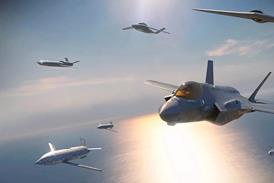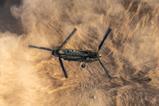Airbus will later this year begin assembly of the initial flight-representative fuel-cell powertrain it is developing under its ZEROe initiative, ahead of ground testing in 2024.
A second version of the same engine will later be installed on the airframer’s A380 flying testbed in preparation for flight tests starting in 2026.
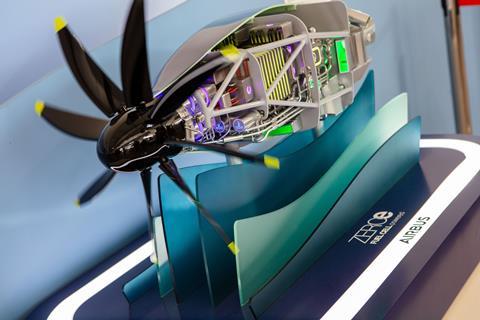
It marks striking progress for the project – the first time Airbus has developed its own engine – since it was disclosed in late 2022.
Under the ZEROe programme, Airbus intends to put a hydrogen-powered aircraft into service in the mid-2030s.
Airbus recently announced that it had run an experimental version of the powertrain, what it calls the ‘iron pod’, at its full 1.2MW output during trials in November 2023 at its site in Ottobrunn, near Munich in southern Germany.
For the first time this included electric motors and gearbox with an electromechanical load taking the place of a propeller.
Since then, the full system has racked up hundreds of hours of testing, including simulated flight cycles, says Glenn Llewellyn, vice-president ZEROe aircraft at Airbus. In all, a total of 45 tests have been performed over a period of 15 days.
Llewellyn says the vast quantity of data accumulated during the evaluations to date “is giving us a lot of confidence about the system itself”, describing it as the “first ever Airbus-built engine”.
“It’s essentially a fully electric aircraft, therefore it can be pretty close to zero climate impact.
“That’s pretty exciting for us – for Airbus and for the teams involved – and it has given us a huge boost in terms of confidence and energy to achieve the next phase of activity.”
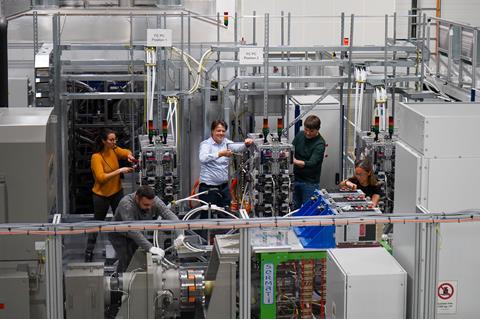
Although testing of the ‘iron pod’ will continue throughout 2024, design work to optimise the system for flight is “in full swing right now”, he says.
Build-up of the first engine to test will begin “towards the end of this year” in Toulouse, adds Llewellyn, to be followed by a second example for flight testing.
“What we are really focused on doing is using the learning we are getting out of the ground testing in Munich to feed into the flight-test demonstrator and build an even-better [engine].”
The system is cooled using ambient air and heat exchangers, which circulate coolant throughout the motor. While this typically relies on the propellers turning to push air into an inlet at the front of the engine, fans are also fitted to allow for operation of the fuel cells in isolation.
At 1.2MW output, the engine is sized for an aircraft capable of carrying 100 passengers on routes of 1,000nm (1,850km) using a six-motor configuration. If a four-motor design is preferred, then a 2MW system would be required.
Airbus estimates that somewhere in the region of 8MW in total would be needed to power an aircraft equivalent to a current-generation turboprop.
No decision has been taken on a final aircraft configuration, but Llewellyn says system growth is “something we are exploring as part of the activities we are running”.
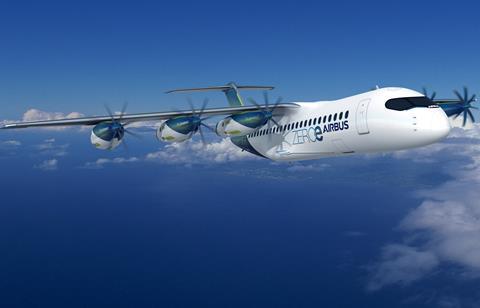
In addition, the airframer continues to evaluate whether it would bring the system to market as an Airbus powertrain, a reversal of its current relationship with the major propulsion suppliers.
“We are certainly building the capability as Airbus to integrate that propulsion system and to be able to test that propulsion system ourselves.
“We have not made any decisions about what partnering scheme we might ultimately have for commercialisation but we are certainly doing all of that integration work ourselves with many partners,” says Llewellyn.
Aerostack, a joint venture between Airbus and ElringKlinger, has supplied the fuel cells for the propulsion system, while the electric motors have been developed by Nidec Leroy-Somer. Other programme partners include Magna, Airbus Helicopters, Diehl Aviation, and Liebherr Toulouse.
Separately, Airbus UpNext, the manufacturer’s innovation arm, has been assessing the potential for cryogenic superconductivity aboard future aircraft through its ASCEND project. This culminated last November with the successful test of a 500kW powertrain, consisting of superconducting tape, a cryogenic motor control unit and cooling system, and a superconducting motor.
A superconductive powertrain, which virtually eliminates resistance, could reduce the voltage required for an electric aircraft, practically eliminating losses while reducing the weight and size of the overall system.
While such a system is not being considered for the current ZEROe flight-test programme, Llewellyn sees the technology as “very interesting” by enabling higher power levels on board the aircraft.
“It could be an enabler for a 200-seat electric aircraft, and that’s, of course, a big deal if that kind of technology can be developed.”
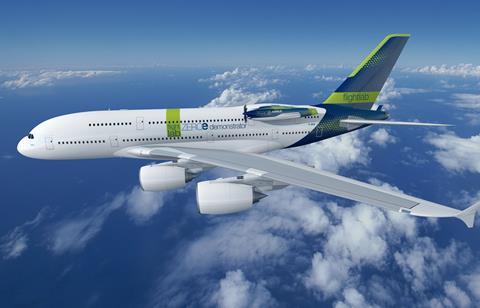
Similar considerations around the difficulties presented by high voltages have prompted Airbus to use a gearbox in the powertrain rather than a direct-drive motor, says Llewellyn.
“So, our choice for now is to avoid some of the challenges associated with coupling electrically and go for a mechanical coupling in the gearbox.”
Meanwhile, Airbus last September announced that it was investing in hydrogen start-up ZeroAvia and would also look to collaborate with the powertrain developer, which is already flying a 600kW system.
Discussions between the pair have progressed since then, says Llewellyn, although he declines to elaborate on their content.





